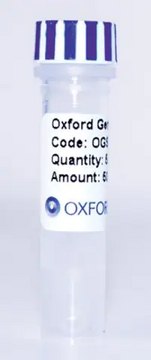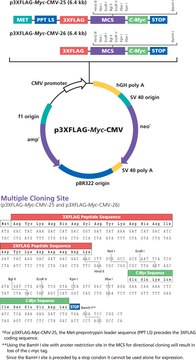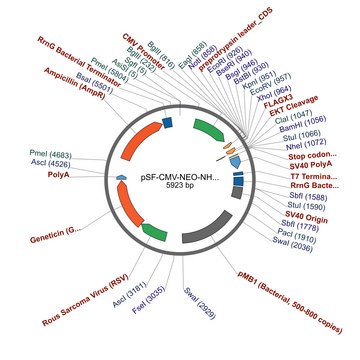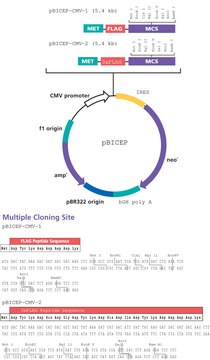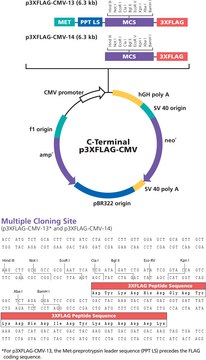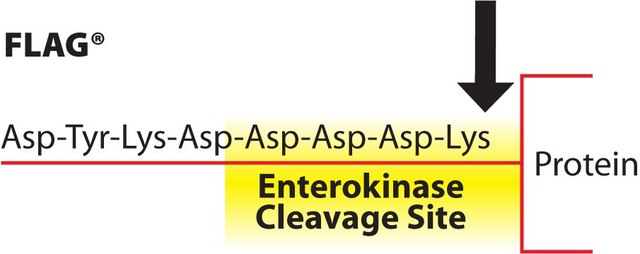E9783
p3XFLAG-CMV™-9 Expression Vector
Shuttle vector for transient or stable expression of secreted N-terminal 3xFLAG fusion proteins
Sign Into View Organizational & Contract Pricing
Select a Size
All Photos(2)
Select a Size
Change View
About This Item
UNSPSC Code:
12352200
Recommended Products
tag
3X FLAG tagged
grade
Molecular Biology
form
buffered aqueous solution
shipped in
dry ice
storage temp.
−20°C
General description
The p3XFLAG-CMV™-9 Expression Vector is a 6.4 kb derivative of pCMV5 used to establish transient or stable expression of secreted N-terminal 3XFLAG™ fusion proteins in mammalian cells. The vector encodes three adjacent FLAG?epitopes (Asp-Tyr-Lys-Xaa-Xaa- Asp) upstream of the multiple cloning region. This results in increased detection sensitivity using ANTIFLAG M2 antibody. The third epitope includes the enterokinase recognition sequence, allowing cleavage of the 3XFLAG peptide from the purified fusion protein.
p3XFLAG-CMV-9 expression vector is a shuttle vector for E. coli and mammalian cells. Efficiency of replication and genomic integration is optimal when using an SV40 T antigen expressing host, such as COS cells. A related vector, p3XFLAG-CMV-3, has been used for stable transfection of HEK 293 cells. Efficiency of replication and genomic integration is optimal when using an SV40 T antigen-expressing host.
The p3XFLAG-CMV-7-BAP Control Plasmid is a 6.2 kb derivative of pCMV5 used for transient intracellular expression of N-terminal 3XFLAG bacterial alkaline phosphatase fusion protein in mammalian cells. The vector encodes three adjacent FLAG epitopes (Asp-Tyr-Lys-Xaa-Xaa-Asp) upstream of the multiple cloning region. This results in increased detection sensitivity using ANTI-FLAG M2 antibody. The third FLAG epitope includes the enterokinase recognition sequence, allowing cleavage of the 3XFLAG peptide from the purified fusion protein.
Vector Maps and Sequences
p3XFLAG-CMV-9 expression vector is a shuttle vector for E. coli and mammalian cells. Efficiency of replication and genomic integration is optimal when using an SV40 T antigen expressing host, such as COS cells. A related vector, p3XFLAG-CMV-3, has been used for stable transfection of HEK 293 cells. Efficiency of replication and genomic integration is optimal when using an SV40 T antigen-expressing host.
The p3XFLAG-CMV-7-BAP Control Plasmid is a 6.2 kb derivative of pCMV5 used for transient intracellular expression of N-terminal 3XFLAG bacterial alkaline phosphatase fusion protein in mammalian cells. The vector encodes three adjacent FLAG epitopes (Asp-Tyr-Lys-Xaa-Xaa-Asp) upstream of the multiple cloning region. This results in increased detection sensitivity using ANTI-FLAG M2 antibody. The third FLAG epitope includes the enterokinase recognition sequence, allowing cleavage of the 3XFLAG peptide from the purified fusion protein.
Vector Maps and Sequences
Components
- p3XFLAG-CMV™-9 Expression Vector 20 μg (E4276) is supplied as 0.5 mg/ml in 10 mM Tris-HCl (pH 8.0) with 1 mM EDTA.
- p3XFLAG-CMV™-7-BAP Control Plasmid 20 μg (C7472) is supplied as 0.5 mg/ml in 10 mM Tris-HCl (pH 8.0) with 1 mM EDTA.
Principle
The promoter-regulatory region of the human cytomegalovirus drives transcription of FLAG®-fusion constructs. The preprotrypsin leader sequence precedes the FLAG® sequence. The aminoglycoside phosphotransferase II gene (Neo-r) confers resistance to aminoglycosides such as G418 allowing for selection of stable transfectants.
Legal Information
This product is covered by the following patents owned by Sigma-Aldrich Co. LLC: US6,379,903, US7,094,548, JP4405125,EP1220933, CA2386471 and AU774216.
3xFLAG is a trademark of Sigma-Aldrich Co. LLC
FLAG is a registered trademark of Merck KGaA, Darmstadt, Germany
p3xFLAG-CMV is a trademark of Sigma-Aldrich Co. LLC
Storage Class Code
10 - Combustible liquids
Regulatory Information
新产品
Choose from one of the most recent versions:
Already Own This Product?
Find documentation for the products that you have recently purchased in the Document Library.
A cis-acting five-amino-acid motif controls targeting of ABCC2 to the apical plasma membrane domain.
Yoshikazu Emi et al.
Journal of cell science, 125(Pt 13), 3133-3143 (2012-03-29)
ATP-binding cassette transporter isoform C2 (ABCC2) is exclusively targeted to the apical plasma membrane of polarized cells. Although apical localization of ABCC2 in hepatocytes is crucial for the biliary excretion of a variety of metabolites, the mechanism regulating its apical
Nikolai A Shevchuk et al.
Nucleic acids research, 32(2), e19-e19 (2004-01-24)
A procedure for precise assembly of linear DNA constructs as long as 20 kb is proposed. The method, which we call long multiple fusion, has been used to assemble up to four fragments simultaneously (for a 10.8 kb final product)
Sylvie Brassart-Pasco et al.
PloS one, 7(4), e29587-e29587 (2012-04-28)
NC1 domains from α1, α2, α3 and α6(IV) collagen chains were shown to exert anti-tumor or anti-angiogenic activities, whereas the NC1 domain of the α4(IV) chain did not show such activities so far. We demonstrate in the present paper that
Louise Bacon et al.
Journal of immunology (Baltimore, Md. : 1950), 173(2), 1078-1084 (2004-07-09)
We characterized two novel members of the RAET1/ULBP gene cluster, RAET1E and RAET1G. The encoded proteins were similar to the ULBP in their class I-like alpha1 and alpha2 domains, but differed in that, instead of being GPI-anchored, their sequences were
Shuling Fan et al.
The Journal of cell biology, 178(3), 387-398 (2007-07-25)
The Crumbs family of apical transmembrane proteins regulates apicobasal polarity via protein interactions with a conserved C-terminal sequence, ERLI. However, one of the mammalian Crumbs proteins, Crumbs3 (CRB3) has an alternate splice form with a novel C-terminal sequence ending in
Our team of scientists has experience in all areas of research including Life Science, Material Science, Chemical Synthesis, Chromatography, Analytical and many others.
Contact Technical Service